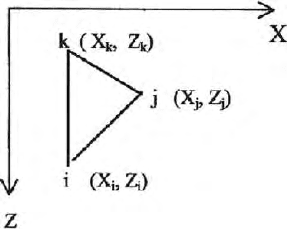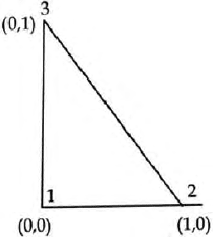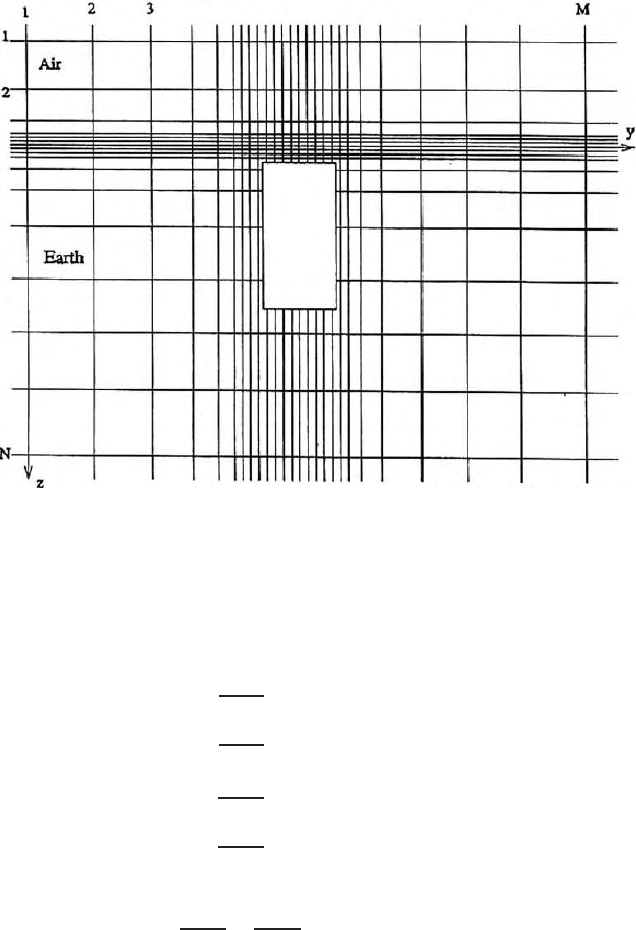Roy K.K. Potential theory in applied geophysics
Подождите немного. Документ загружается.

15.7 Finite Element Formulation Galerkin’s Approach Magnetotellurics 509
[A].[φ]=[S]. (15.115)
For a 3-D problem with tetrahedral elements,the matrix A will be a hepta
diagonal,diagonally dominant sparse symmetric matrix.Suitable matrix solver
may be used to obtain φ at all the nodes.
15.7 Finite Element Formulation Galerkin’s Approach
Magnetotellurics
15.7.1 Introduction
Coggon (1971), Silvester and Heslam (1972), Rodi (1975), Pelton et al (1978),
Wannamaker (1984, 1987), Kikkonen (1977) did mathematical formulaton on
finite element method for geo-electric and geo electromagnetic problems. In
this section we present a brief description of the finite element method for TE
and TM mode magnetotellurics (Plane wave normal incidence electromagnet-
ics). The finite element approach for solution of the Helmoltz wave equation
is presented.
Let us consider TE mode MT in which E
x
=E
z
=H
y
= ∂/∂y=0.For
harmonic fields in the case of plane wave electromagnetics, we get
∂E
y
/∂z=iωµ H
x
(15.116)
∂E
y
/∂z=−iωµ H
z
(15.117)
and
∂H
x
/∂z − ∂H
z
/∂x=iωε E
y
. (15.118)
We get
∂/∂x(1/iωµ ∂E
y
/∂x) + ∂/∂z(1/iωµ ∂E
y
/∂z) − iω ∈ E
y
=0. (15.119)
For TM mode, we get
E
y
=H
x
=H
z
= ∂/∂y=0
and
∂H
y
/∂z=−iω ∈ E
x
(15.120)
∂H
y
/∂x=iω ∈ E
z
(15.121)
and
∂E
x
/∂z − ∂E
z
/∂x=−iωµ H
y
. (15.122)
Substituting (15.120) and (15.121) in (15.122), we obtain
∂/∂x(1/iω ∈ ∂H
y
/∂x) + ∂/∂z(1/iω ∈ ∂H
y
/∂z) − iωµ H
y
=0. (15.123)
The general expression for two d imensional Helmoltz equation is
∂/∂x(1/k ∂f/∂x) + ∂/∂y(1/k ∂f/∂y) + p(f) = S. (15.124)
510 15 Numerical Methods in Potential Theory
15.7.2 Finite Element Formulation for Helmholtz Wave Equations
This finite element formulation is based on the work of Wannamaker (1984,
1986 and 1987) The finite element formulation is constructed as follows:
(a) The region is divided into finite number of sub-domains selected here as
triangular elements. These elements are connected at common node points
and collectively form the shape o f the region.
(b) The continuous unknown function ‘f’ is approximated over each element
by polynomials selected here as lin ear polynomia ls. These polynomials are
defined using the noded values of the continuous function ‘f’. The value
of a continuous function ‘f’ at each nodal point is denoted as a variable
which is to be determined.
(c) The equations for b ehaviours of field over each element are derived from
the Helmholtz equation using linear polynomials.
(d) The regions of application of Neumann and Dirichlet boundary conditions
are established.
(e) Element equations are converted into element matrix equations.
(f) The matrix element equations are assembled to form the global matrix
equations.
(g) The boundary conditions are introduced.
(h) The system of linear equations are solved.
One important aspect of the finite element method is the design of the dis-
cretized domain i.e. the construction of finite element mesh. The construction
of the mesh is problem dependent. The working domain is discretized with
finite elements of different 2-D or 3-D shapes depending upon the dimension
of the problem. The size of the mesh must be variable and near the discontinu-
ities the mesh size should be finer. The area where there is no inhomogeneity
the mesh can be coarser. For two dimensional bodies triangular, rectangu-
lar, hexagonal meshes can be used. For 3-D b odies cubical parallelopiped,
tetrahedral elements can be used. Depending upon the nature of complexity
complicated isoparametric elements with 8 nodes, 20 nodes, 32 nodes cubic
elements can be used as shown in the next section. The connecting points of
all the elements are nodes. In the discretized domain we try to find out the
fields or potentials at these nodal points.
In the following section we present the basics of fi nite element formula-
tion for magnetotelluric boundary value problems using triangular elements.
Initial part of the formulation is same as that outlined in the previous sec-
tion. In this section the Galerkins methods is used. So the formulation takes
a different path. The elements are triangular, the simplest elements for a two
dimensional problem. The guiding equations are electromagnetic wave equa-
tions and Maxwell’s electromagnetic equations. The boundary conditions are
mentioned in the Sect. 15.4.
We assume an arbitrary triangular element (e) within the finite domain
with nodes at the vertices of the triangles (Fig. 15.19).

15.7 Finite Element Formulation Galerkin’s Approach Magnetotellurics 511
Fig. 15.19. Triangular finite element for MT field formulation
With this type of domain discretization we allowed the functional to vary
linearly over each element. The plane passing through the nodal values of ‘f’
attached with each element (e) can be described by the equation:
f
e
(x, y) = a
(e)
1
+a
(e)
2
X+a
(e)
3
Z. (15.125)
At the three nodes the values of the assumed polynomials are:
f
(e)
i
(x, y) = α
(e)
1
+ α
(e)
2
X
i
+ α
(e)
3
Z
i
(15.126)
f
(e)
j
(x, y) = α
(e)
1
+ α
(e)
2
X
j
+ α
(e)
3
Z
j
(15.127)
f
(e)
k
(x, y) = α
(e)
1
+ α
(e)
2
X
k
+ α
(e)
3
Z
k
.
We solve these equations for α
1
, α
2
and α
3
and insert these values in (15.125)
to get
f
e
=N
(e)
i
f
(e)
i
+N
(e)
j
f
(e)
j
+N
(e)
k
f
(e)
k
(15.128)
in which
N
(e)
i
=1/2∆(a
i
+b
i
X+c
i
Z) (15.129)
where
a
i
=x
j
z
k
− x
k
z
j
(15.130)
b
i
=z
j−
z
k
c
i
=x
k
− x
j
(15.131)
and ∆ is the area of the triangular element (e). Like wise the terms N
(e)
j
and
N
(e)
k
are obtained through a cyclic permutations of the subscripts i, j and k.
The functions N
(e)
i
,N
(e)
j
and N
(e)
k
are called the shape functions, interpolation
function or the basis function.
Equation (15.128) can be expressed as the matrix equation in the form
f
(e)
=N
(e)
f
t
(e)
. (15.132)

512 15 Numerical Methods in Potential Theory
In which
N
(e)
=[N
(e)
i
N
(e)
j
N
(e)
k
] (15.133)
and
f
T
e
=[f
(e)
i
f
(e)
j
f
(e)
k
]. (15.134)
If the domain contains M triangular elements, the complete representation
of the unknown function ‘f’ over the whole domain is given by
f(x, z)=
M
e=1
f
e
(x, z)=
M
e=1
N
e
f
T
e
. (15.135)
This is the function ‘f’ defined over whole domain. We shall derive the element
equations.
15.7.3 Element Equations
The domain equation may be written in the concise form as
L f = s (15.136)
In which
L =
∂
∂x
1
k
∂
∂x
+
∂
∂y
1
k
∂
∂y
+ P (15.137)
Inserting the approximate value of f(x, z) given by (15.136) and (15.137) we
get
L(
N
(e)
f
T
(e)
) − s=ε (15.138)
in which ε is the residual error to be minimized. Our way to accomplish this
objective is to use the inner product or dot-product between the error vector
and the function. The dot product becomes zero when they are orthogonal or
<N
e
j
,ε>=
(e)
N
(e)
h
εdxdz = 0 (15.139)
for each of the basis function N
(e)
h
. This integral mathematically states that
the basis function must be orthogonal to the error over the element (e). This
is Galerkin’s method.
Using (15.136) to (15.139), we can write
(e)
[N
e
n
[
∂
∂x
(
1
k
∂f
e
∂x
)] + Pf
(e)
− s]dxdz = 0 (15.140)
in which (e) is the triangular region and n = i, jandk.
Applying integration by parts, we get

15.7 Finite Element Formulation Galerkin’s Approach Magnetotellurics 513
(e)
N
(e)
n
∂
∂x
(
1
k
∂f
(e)
∂x
)dxdz = −
1
k
∂f
(e)
∂x
∂N
(e)
n
∂x
dxdz +
1
k
∂f
(e)
∂x
n
x
N
(e)
n
dl
(15.141a)
in which n
x
is the x-component of the unit normal to the boundary, dl is a
differential arc length along the boundary. When we treat the second term in
(15.140) in the same manner, the (15.140) takes the form
(e)
[−
1
k
(
∂f
(e)
∂x
∂N
n
∂x
−
∂f
(e)
∂z
∂N
(e)
n
∂z
)+N
n
(Pf
(e)
− s)]dxdz
+
1
k
∂f
(e)
∂n
N
(e)
n
dl = 0 (15.141b)
in which
∂f
(e)
∂n
=
∂f
(e)
∂x
n
x
+
∂f
(e)
∂z
n
z
. (15.142)
With the surface integral in (15.141b) and selected boundary conditions, we
can write (15.141b) using (15.140,15.141a)
−
1
k
(
∂N
(e)
∂x
f
T
∂N
(e)
n
∂x
+
∂N
(e)
∂z
f
T
∂N
(e)
n
∂z
)dxdz +
(e)
PN
(e)
f
T
(e)
N
(e)
n
dxdz
−
(e)
SN
(e)
n
dxdz = 0 (15.143)
in which n = i, j, k. We can rewrite (15.143) in the matrix form as
(K
(e)
+ P
(e)
)f
T
(e)
= S
T
(e)
(15.144)
in which the matrices K
(e)
,P
(e)
and vector S
T
(e)
have the entities
K
ij
= −
(e)
1
k
(
∂N
i
∂x
·
∂N
j
∂x
+
∂N
i
∂z
∂N
j
∂z
)dxdz (15.145)
P
ij
=
(e)
PN
i
N
j
dxdz (15.146)
and
S
i
=
e
SN
i
dxdz. (15.147)
Assuming K and P to be constant within the element e and using (15.144) to
(15.146) and the integral

514 15 Numerical Methods in Potential Theory
(e)
N
a
i
N
b
j
N
c
k
dxdz =
2a!b!c!∆
(a + b + c +2)!
(15.148)
in which ∆ is the area of the element, we may write (15.134) to (15.145) as
−
1
4k∆
⎡
⎣
b
2
i
+ c
2
i
b
i
b
j
+ c
i
c
j
b
i
b
k
+ c
i
c
k
b
2
j
+ c
2
j
b
j
b
k
+ c
j
c
k
b
2
k
+ c
2
k
⎤
⎦
+
P ∆
12
⎡
⎣
211
121
112
⎤
⎦
f
T
(e)
+ S
T
(e)
=0. (15.149)
It is interesting to note that (15.149) is applicable for MT, DC resistivity, EM
etc. , but source term will be different in different problems. Imposition of
boundary condition will also be different for different problems. For magne-
totelluric problem S
T
(e)
is identically zero.
Equation (15.149) is known as element matrix equation for the triangular
element (e). For each element in the domain an equation of the form (15.148)
can be derived. These equations can be assembled (summed) into a single
matrix equation. Details of the assemblage of the global matrix equation ar e
discussed in the Sect. 15.5 and given in Zienkiewicz (1971). The global matrix
equation can be written as
Gf = S (15.150)
where G is a N×N symmetric, sparse, banded and diagonally dominant matrix
and N is the total number of nodal points in the entire discretized domain.
The vector f is a column vector of N unknown values of the function f (x, z)
at each node of the model. The vector S is a column vector that contains the
source information given by adding the contribution of all the source terms
S
(e)
=
αI
360
⎡
⎣
0
0
1
⎤
⎦
(15.151)
where α is the angle subtended by element e. I is the current strength. It is
applicable for DC resistivity and not for MT. For the global matrix, all the
boundary conditions dema nd ed by the problem must be introduced first and
then the matrix equation is solved using one of the suitable matrix solver viz.,
(i) Gauss Elimination (ii) Gauss-Siedel Iteration (iii) Cholesky’s Decomposi-
tion (iv) Conjugate Gradient Minimization etc. Thus the unknown value of
‘f’ i.e. E or H in this case of MT and potential in the case of DC resistivity
at all the nodal points will be obtained. Boundary conditions for MT and DC
resistivity are considerably different as discussed already.

15.8 Galerkin’s Approach Isoparametric Elements Magnetotellurics 515
15.8 Finite Element Formulation Galerkin’s Approach
Isoparametric Elements Magnetotellurics
15.8.1 Introduction
In t hi s section a brief presentation on the structure of finite element formu-
lation using isoparametric elements and Galerkin’s method is given. Since
Galerkin’s method is discussed in the previous section with all it’s essential
details, some of the steps will be avoided while demonstrating the finite ele-
ment formulation using eight noded isoparametric elements (Murthy 2000).
Basic structure of formulation is based on the work of Wannamaker et al
(1987). All the details about mesh generation, boundary conditions in TE
and TM mode Plane wave electromagnetics , governing differential equ ations
are given in Sects. 15.4 and 15.7. A few p o ints ab out isoparametric elements
and natural coordinates are added here.
To simulate a complicated and sharp curvatures of a bound ary of a body of
irregular shape, one needs numerous small elements straight edges to reduce
the difference in shape of the actual and simulated body. Isoparametric ele-
ments can significantly reduce the number of elements to be taken because
the elements can take care of curved boundaries of a body very effectively.
These elements are typically meant for bodies of arbitrary shap es. In isopara-
metric domain the coordinates are called natural coordinates and they are
nondimensional. These elements are called isoparametric because the number
of nodes in an element in cartisian coordinate and natural coordinates are
same.
For any variable function Φ within a triangular parent element (simplest
2D element) the prescribed values at the nodes can be obta in ed assuming a
linear polynomial function within the element as
Φ=α
1
+ α
2
ξ + α
3
ζ. (15.152)
In this Fig. (15.20)
Fig. 15.20. A simplest triangular element with natural coordinate
516 15 Numerical Methods in Potential Theory
Since
Φ=Φ
1
at node 1(ξ =0, ζ =0),
Φ=Φ
2
at node 2(ξ =1, ζ = 0) (15.153)
Φ=Φ
3
at node 3(ξ =0, ζ =1),
from (15.153), we get
α
1
=Φ
1
α
1
+ α
2
=Φ
2
(15.154)
α
1
+ α
3
=Φ
3
.
The polynomial coefficients from these equation are
α
1
=Φ
1
α
2
=Φ
2
− Φ
1
(15.155)
α
3
=Φ
3
− Φ
1
.
Substituting these values, the (15.152) can be written as
Φ=N
1
Φ
1
+N
2
Φ
2
+N
3
Φ
3
(15.156)
where Φ
1
,Φ
2
and Φ
3
are nodal potentials or fields and N
1
,N
2
and N
3
are
element shape functions. They are connected to the natural coordinates in
isoparametric domain as
N
1
=1− ξ −ζ
N
2
= ξ (15.157)
N
3
= ζ
From (15.154), (15.155), (15.156) and (15.157) we get where
N
1
+N
2
+N
3
= 1 (15.158)
N
i
=1
N
j
=0
N
k
=0.
Thus we can write the connecting relationship between the cartisian coordi -
nates and the natural coordinates as
X
Z
=
3
i=1
N
i
(ξ, ζ)
X
i
Z
i
(15.159)
where X
i
and Z
i
are the cartisian coordinates of the ith element. The con-
necting link between the fields at the centre of a triangle and the nodal values
are

15.8 Galerkin’s Approach Isoparametric Elements Magnetotellurics 517
E
x
E
z
=
3
i=1
N
i
(ξ, ζ)
E
X
i
E
Z
i
. (15.160)
The cartisian derivatives of the shape function N
i
in terms of the natural
coordina t es can be written as
∂N
i
∂ξ
=
∂N
i
∂x
∂x
∂ξ
+
∂N
i
∂z
∂z
∂ξ
(15.161)
∂N
i
∂ζ
=
∂N
i
∂x
∂x
∂ζ
+
∂N
i
∂z
∂z
∂ζ
(15.162)
which in matrix form can be written as
⎡
⎢
⎣
∂N
i
∂ξ
∂N
i
∂ζ
⎤
⎥
⎦
=
⎡
⎢
⎣
∂x
∂ξ
∂z
∂ξ
∂x
∂ζ
∂z
∂ζ
⎤
⎥
⎦
⎡
⎢
⎣
∂N
i
∂x
∂N
i
∂z
⎤
⎥
⎦
=[J]
⎡
⎢
⎣
∂N
i
∂x
∂N
i
∂z
⎤
⎥
⎦
. (15.163)
where J is the Jacobian matrix and can be evaluated using
|J| =
3
i=1
⎡
⎣
∂N
i
∂ξ
x
i
∂N
i
∂ξ
z
i
∂N
i
∂ζ
x
i
∂N
i
∂ζ
z
i
⎤
⎦
. (15.164)
The derivatives of shape function in Cartisian coor dinate can be obtained in
terms of natural coordinate and can be written as
⎡
⎣
∂N
i
∂x
∂N
i
∂ζ
⎤
⎦
=[J]
−1
⎡
⎣
∂N
i
∂ξ
∂N
i
∂ζ
⎤
⎦
(15.165)
where the determinant of the Jacobian matrix must be n on zero.
15.8.2 Finite Element Formulation
Figure (15.21) shows the typical mesh generated using the quadrilateral finite
elements. A h omogeneous external region is included in the mesh to facilitate
inclusion of boundary conditions. The resistivity of this region is held fixed at
the average value of the apparent resistivity data. The no dal field values at the
bottom and sides of the mesh are set equal to the analytical values obtained
for the homogeneous space. Vertical element dimensions may be increased
approximately exponentially downward from the air-earth interface because
of exponential decay of the fields. Along the horizontal element boundaries,
we extended the mesh from fine to coarse as we go away from the working
zone. The nodes in the y-direction are indexed by i = 1, 2, 3 ...Mandthe
nodes in the z- d i rections are j = 1, 2, 3 ...N.
Taking the x-axis pa rallel to strike, y-axis in the horizontal and z-axis
positive downward, for the TE mode 2-D geometries, E
y
=E
z
=H
x
=
∂
∂x
=0.

518 15 Numerical Methods in Potential Theory
Fig. 15.21. A finite element mesh with quadrilateral boundaries;model shows the
air-earth b oundary and air layers on top of it,the anomalous body and the host
rocks;expanding grid is shown b oth upward,downward ans lateral directions from
the centre of the body
From Maxwell’s equations we can write
∂E
xs
∂z
=ˆzH
ys
(15.166)
∂E
xs
∂y
=ˆzH
zs
(15.167)
∂H
xs
∂z
=ˆyE
ys
+∆ˆyE
yp
(15.168)
∂H
xs
∂y
=ˆyE
zs
+∆ˆyE
zp
(15.169)
and
∂H
zs
∂y
−
∂H
ys
∂z
=ˆyE
xs
+∆ˆyE
xp
(15.170)
(Chaps. 12 and 13 and Table 15.1)) where ˆy = σ + iω ∈ is the admittivit y,
ˆz = iωμ
o
is the impedivity, ∆ˆy =ˆy
i
˜ˆy
j
.whereˆy
i
and ˆy
j
indicates the admit-
tivity difference between the layered host and its 2D inhomogeneity. Subscripts
p and s refer to primary (layered earth) and secondary field components.
Substituting (15.166) and (15.167) into (15.168) , the TE mode Helmholtz
